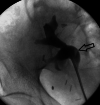Radiolucent Matrix Stones in a Transplanted Kidney: A Case Report
- PMID: 37255892
- PMCID: PMC10226156
- DOI: 10.7759/cureus.38280
Radiolucent Matrix Stones in a Transplanted Kidney: A Case Report
Abstract
Matrix stones are a rare form of kidney stones, which are composed of mucoproteinaceous material. They are often difficult to diagnose as they are characteristically radiolucent on CT urinary tract. This difficulty is compounded in transplanted kidneys as obstructing stones commonly present without pain and can cause acute kidney injury. Here, we present a case of a 61-year-old female with a live-donor kidney transplant, who was found to develop deranged renal function on routine follow-up investigations. Therefore, a CT urogram was performed and it showed filling defects in the renal pelvis and upper ureter of the transplanted kidney. Therefore, diagnostic ureterorenoscopy was performed and three stones of about 7-8 mm each were found in the renal pelvis, they were treated by Holmium:Yttrium aluminium garnet (YAG) laser fragmentation. This case report describes the challenges in the management of this rare stone in a transplanted kidney.
Keywords: colloid calculi; endo urology; kidney transplant recipient; matrix stone; radiolucent kidney stone; renal stone disease; renal stone surgery.
Copyright © 2023, Adhoni et al.
Conflict of interest statement
The authors have declared that no competing interests exist.
Figures
References
-
- Incidence of kidney stones in kidney transplant recipients: a systematic review and meta-analysis. Cheungpasitporn W, Thongprayoon C, Mao MA, Kittanamongkolchai W, Jaffer Sathick IJ, Dhondup T, Erickson SB. https://doi.org/10.5500/wjt.v6.i4.790. World J Transplant. 2016;6:790–797. - PMC - PubMed
-
- Lithiasis in 1,313 kidney transplants: incidence, diagnosis, and management. Ferreira Cassini M, Cologna AJ, Ferreira Andrade M, Lima GJ, Medeiros Albuquerque U, Pereira Martins AC, Tucci Junior S. https://doi.org/10.1016/j.transproceed.2012.07.052. Transplant Proc. 2012;44:2373–2375. - PubMed
-
- Proteomic analysis of a matrix stone: a case report. Canales BK, Anderson L, Higgins L, Frethem C, Ressler A, Kim IW, Monga M. Urol Res. 2009;37:323–329. - PubMed
Publication types
LinkOut - more resources
Full Text Sources



